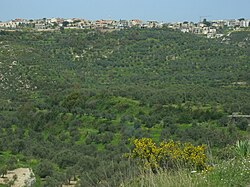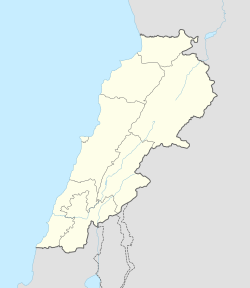Darbechtar
|
Darbechtar داربعشتار |
|
|---|---|
| Village | |

View of Darbechtar.
|
|
| Location within Lebanon | |
| Coordinates: 34°16′06″N 35°47′37″E / 34.26833°N 35.79361°ECoordinates: 34°16′06″N 35°47′37″E / 34.26833°N 35.79361°E | |
| Country |
|
| Governorate | North Governorate |
| District | Koura District |
| Elevation | 300 m (1,000 ft) |
| Time zone | EET (UTC+2) |
| • Summer (DST) | EEST (UTC+3) |
| Dialing code | +961 |
Darbechtar ( known also as Darb Ishtar, Arabic: داربعشتار) is a village located on the South-Eastern periphery of the Koura District in the North Governorate of the Republic of Lebanon.
Darbechtar borders the villages of Amyoun, Bziza, Majdel, Kaftoun, and Dar-shmizzine.
The Lebanese hailing from Darbechtar number 10,000 worldwide. 85% of them live outside Lebanon, mainly in Brazil, Argentina, Australia, Canada, the United States, and Uruguay.)
The population of Darbechtar is Greek Orthodox and Maronite Christian.
The name of the village is derivative of the Aramaic words, Dar and Ishtar, meaning the House of Astarte. It is believed that the village was the site of an ancient Phoenician shrine for the Goddess of Fertility.)
Darbechtar : Mediterranean plain village with heavy rains, mild winters and hot dry arid summers.
Min / Max average temperatures in Celsius Degree
Jan (8/16) Feb (9/16) Mar (10/19) Apr (13/22) May (16/25) Jun (19/27) Jul (22/29) Aug (23/30) Sep (20/29) Oct (17/27) Nov (13/22) Dec (10/18)
The village is the home of Olive oil production. Therefore, most of the village is planted with the ever green Olive Trees along with Grapes, Figs, variety of bushes, plants, and flowers.)
Traditionally, olive oil was produced by crushing olives in stone or wooden mortars or beam presses. Nowadays, olives are ground to tiny bits, obtaining a paste that is mixed with water and processed by a centrifuge, which extracts the oil from the paste, leaving behind pomace.)
...
Wikipedia

